
Carniola is a historical region that comprised parts of present-day Slovenia. Although as a whole it does not exist anymore, Slovenes living within the former borders of the region still tend to identify with its traditional parts Upper Carniola, Lower Carniola, and to a lesser degree with Inner Carniola. In 1991, 47% of the population of Slovenia lived within the borders of the former Duchy of Carniola.

Vipava is a town in western Slovenia. It is the largest settlement and the seat of the Municipality of Vipava. Vipava is located near the numerous sources of the Vipava River, in the upper Vipava Valley, 102 metres (335 ft) above sea level. Historically, it is part of the traditional region of Inner Carniola, but it is now generally regarded as part of the Slovenian Littoral.

Bled is a town on Lake Bled in the Upper Carniolan region of northwestern Slovenia. It is one of Slovenia's most visited tourist destinations. The town is the administrative seat of the Municipality of Bled.

Sigmund Zois Freiherr von Edelstein, usually referred as Sigmund Zois was a Carniolan nobleman, natural scientist and patron of the arts. He is considered one of the most influential figures of the Enlightenment Era in the Slovene Lands of Habsburg Austria.
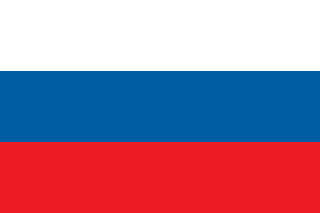
The Duchy of Carniola was an imperial estate of the Holy Roman Empire, established under Habsburg rule on the territory of the former East Frankish March of Carniola in 1364. A hereditary land of the Habsburg monarchy, it became a constituent land of the Austrian Empire in 1804 and part of the Kingdom of Illyria until 1849. A separate crown land from 1849, it was incorporated into the Cisleithanian territories of Austria-Hungary from 1867 until the state's dissolution in 1918. Its capital was German: Laibach, today Ljubljana.
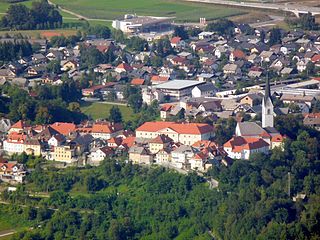
Radovljica is a town in the Upper Carniola region of northern Slovenia. It is the administrative seat of the Municipality of Radovljica.

Begunje na Gorenjskem is a village in the Municipality of Radovljica in the Upper Carniola region of Slovenia. It is known for being the location of the headquarters of the Elan Line company.

Upper Carniola is a traditional region of Slovenia, the northern mountainous part of the larger Carniola region. The largest town in the region is Kranj, and other urban centers include Kamnik, Jesenice, Domžale and Škofja Loka. It has around 300,000 inhabitants or 14% of the population of Slovenia.

Lower Carniola is a traditional region in Slovenia, the southeastern part of the historical Carniola region. Its largest town and urban center is Novo Mesto.

Zois Mansion is a mansion in Ljubljana, the capital of Slovenia. It stands in the Center District, at Breg, a street on the west (left) bank of the Ljubljanica, between Teutonic Street to the north and Zois Street to the south. The mansion served as residence of Baron Sigmund Zois, a leading figure of Enlightenment in the Slovene Lands of the Austrian monarchy and supporter of the revival of Slovene culture and literature.
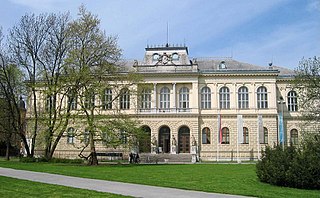
The National Museum of Slovenia is located in Ljubljana, the capital of Slovenia. It is located in the Center district of the city near Tivoli City Park. Along with the Slovenian Museum of Natural History, located in the same building, the National Museum of Slovenia is the country's oldest scientific and cultural institution. The museum has an extensive collection of archaeological artefacts, old coins and banknotes and displays related to the applied arts. In 2021 it's been given the golden Order for Exceptional Merits by the president of Slovenia, Borut Pahor.
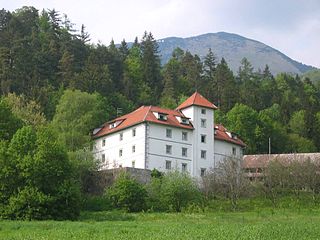
Turn Castle is a castle near the village of Potoče in the Municipality of Preddvor in the Upper Carniolan region of Slovenia.
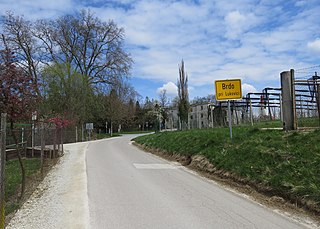
Brdo pri Lukovici is a small settlement next to Lukovica pri Domžalah in the eastern part of the Upper Carniola region of Slovenia.

The Upper Carniolan dialect is a major Slovene dialect, known for extensive syncope, monophthongization of diphthongs, and loss of neuter gender. It is spoken in most of Upper Carniola, along the Sava River. It is one of the two central Slovene dialects and was also used as a written language from the 17th century onward, and especially in the second half of the 18th century. It borders the Selca, Škofja Loka, and Horjul dialects to the south, the Tolmin dialect to the southwest, the Soča dialect to the west, the Gail Valley dialect to the northwest, the Rosen Valley and Ebriach dialects to the north, the Upper Savinja dialect to the northeast, the Central Savinja dialect to the east, and the Lower Sava Valley and Lower Carniolan dialects to the southeast. The eastern part of the dialect is the Eastern Upper Carniolan subdialect. The dialect belongs to the Upper Carniolan dialect group, and it evolved from Upper Carniolan dialect base.
World War II in the Slovene Lands started in April 1941 and lasted until May 1945. The Slovene Lands were in a unique situation during World War II in Europe. In addition to being trisected, a fate which also befell Greece, Drava Banovina was the only region that experienced a further step—absorption and annexation into neighboring Nazi Germany, Fascist Italy, and Hungary. The Slovene-settled territory was divided largely between Nazi Germany and the Kingdom of Italy, with smaller territories occupied and annexed by Hungary and the Independent State of Croatia.

Josef Kalasanz Freiherr von Erberg was a Carniolan botanist, cultural historian, collector, and patron of the arts.

The Urban Municipality of Kranj is one of twelve urban municipalities of Slovenia. It lies in northwestern Slovenia and was established in 1994. Its seat is the town of Kranj. The area traditionally belongs to the region of Upper Carniola and has been included in Upper Carniola Statistical Region since 1995.
Brdo Castle may refer to:

Rupa is a former settlement in the Municipality of Kranj in the Upper Carniola region of Slovenia. It is now part of the city of Kranj.


















